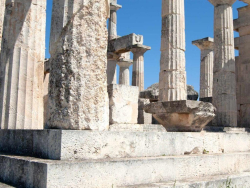Temple of Aphaia (Aegina Island)

Temple of Aphaia (Aegina Island)
The magnificent Doric temple is found on a c. 160 m pine-clad hill on the northeastern surface of the Island of Aegina that dates back to 500 B.C.. This is the considered one of the most important monuments of the Attica region, which appears to have been founded on a site used for worship since the Mycenaean period. A notably mysterious legend states that the Temple of Aphaia is thought to form a "holy triangle" (isosceles) with the Temple of Poseidon in Sounio and the Parthenon Temple of the Acropolis of Athens.
Aphaia has wonderfully sculpted pediments and a very large part of it is exhibited at the "Glyptothek" of Munich - such as the stolen statue of Theseus (n amazing work of art dating back to 500 B.C.). Meaningful numbers of Late Bronze Age figurines have been discovered at the site, including proportionally large numbers of female figurines (kourotrophoi), indicating – perhaps – that cult activity at the site was continuous from the 14th Century B.C., suggesting a Minoan connection for the cult.
The last temple is of an irregular design and is also notable for its pedimental sculptures, which are thought to illustrate the change from Archaic to Early Classical technique. This variety of excavation findings are not only on display at the Glyptothek, but a number of fragments are also located in the Archaeological Museum of Aegina.








